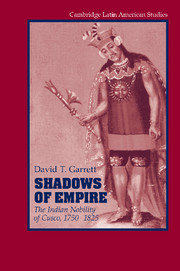Book contents
- Frontmatter
- Contents
- List of Illustrations
- Acknowledgments
- Pueblos Mentioned in Text
- Pueblos on Maps, by Province
- Introduction
- Part I INDIAN ELITES AND THE COLONIAL ORDER
- Part II THE INDIAN NOBILITY OF BOURBON CUSCO
- 3 Cacical Families and Provincial Nobilities
- 4 Communal Economies and Indian Fortunes
- 5 The Politics of the Cacicazgo
- Part III CRISIS AND COLLAPSE
- Conclusion
- Appendix
- Glossary
- Bibliography
- Index
3 - Cacical Families and Provincial Nobilities
Published online by Cambridge University Press: 19 October 2009
- Frontmatter
- Contents
- List of Illustrations
- Acknowledgments
- Pueblos Mentioned in Text
- Pueblos on Maps, by Province
- Introduction
- Part I INDIAN ELITES AND THE COLONIAL ORDER
- Part II THE INDIAN NOBILITY OF BOURBON CUSCO
- 3 Cacical Families and Provincial Nobilities
- 4 Communal Economies and Indian Fortunes
- 5 The Politics of the Cacicazgo
- Part III CRISIS AND COLLAPSE
- Conclusion
- Appendix
- Glossary
- Bibliography
- Index
Summary
The colonial Indian elite – part nobility of blood, part nobility of office – received recognition of its privileges as individuals, families, and even ayllus. But the Indian elite had no official role in the governance of Peru above the level of the pueblo: no cortes or assemblies bound them together. Nor did such institutions bind together creole Peru, but urban, provincial, and viceregal offices in the church and royal government helped to forge a more unified Spanish elite that ruled Peru. The Spanish had usurped imperial, and even provincial, government from the indigenous elite. However, extralocal alliances of Indian elites did not vanish altogether. Some sense of a shared identity, rooted in Inca ancestry, may have bound together a broad Andean elite, although archival evidence for this is very thin. Economic currents did draw migrants across the viceroyalty – with Incas from Cusco moving to Potosí and nobles from Azángaro settling in Lima. Presumably they maintained familial ties with their native communities, although these do not appear to have been sufficiently dense to create the solidarities that would emerge among creoles in the late eighteenth and early nineteenth centuries.
Rather, at the provincial level, localized Indian elites throughout the Andes created their own networks of marital alliances that spanned pueblo, and provincial, frontiers. The result was a series of regional nobilities, in which interrelated cacical families held sway over large swaths of the highlands. In examining the organization of these nobilities, this chapter focuses on the survival or production of provincial Indian elites, the organization of cacical succession in the bishopric, and patterns of marriage alliances. Three caveats are necessary.
- Type
- Chapter
- Information
- Shadows of EmpireThe Indian Nobility of Cusco, 1750–1825, pp. 75 - 113Publisher: Cambridge University PressPrint publication year: 2005

